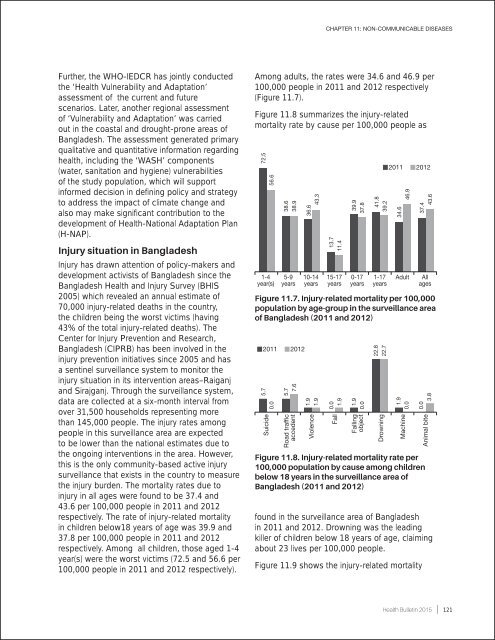1otPoKy
1otPoKy
1otPoKy
Create successful ePaper yourself
Turn your PDF publications into a flip-book with our unique Google optimized e-Paper software.
CHAPTER 11: NON-COMMUNICABLE DISEASES<br />
Further, the WHO-IEDCR has jointly conducted<br />
the ‘Health Vulnerability and Adaptation’<br />
assessment of the current and future<br />
scenarios. Later, another regional assessment<br />
of ‘Vulnerability and Adaptation’ was carried<br />
out in the coastal and drought-prone areas of<br />
Bangladesh. The assessment generated primary<br />
qualitative and quantitative information regarding<br />
health, including the ‘WASH’ components<br />
(water, sanitation and hygiene) vulnerabilities<br />
of the study population, which will support<br />
informed decision in defining policy and strategy<br />
to address the impact of climate change and<br />
also may make significant contribution to the<br />
development of Health-National Adaptation Plan<br />
(H-NAP).<br />
Injury situation in Bangladesh<br />
Injury has drawn attention of policy-makers and<br />
development activists of Bangladesh since the<br />
Bangladesh Health and Injury Survey (BHIS<br />
2005) which revealed an annual estimate of<br />
70,000 injury-related deaths in the country,<br />
the children being the worst victims (having<br />
43% of the total injury-related deaths). The<br />
Center for Injury Prevention and Research,<br />
Bangladesh (CIPRB) has been involved in the<br />
injury prevention initiatives since 2005 and has<br />
a sentinel surveillance system to monitor the<br />
injury situation in its intervention areas–Raiganj<br />
and Sirajganj. Through the surveillance system,<br />
data are collected at a six-month interval from<br />
over 31,500 households representing more<br />
than 145,000 people. The injury rates among<br />
people in this surveillance area are expected<br />
to be lower than the national estimates due to<br />
the ongoing interventions in the area. However,<br />
this is the only community-based active injury<br />
surveillance that exists in the country to measure<br />
the injury burden. The mortality rates due to<br />
injury in all ages were found to be 37.4 and<br />
43.6 per 100,000 people in 2011 and 2012<br />
respectively. The rate of injury-related mortality<br />
in children below18 years of age was 39.9 and<br />
37.8 per 100,000 people in 2011 and 2012<br />
respectively. Among all children, those aged 1-4<br />
year(s) were the worst victims (72.5 and 56.6 per<br />
100,000 people in 2011 and 2012 respectively).<br />
Among adults, the rates were 34.6 and 46.9 per<br />
100,000 people in 2011 and 2012 respectively<br />
(Figure 11.7).<br />
Figure 11.8 summarizes the injury-related<br />
mortality rate by cause per 100,000 people as<br />
72.5<br />
56.6<br />
1-4<br />
year(s)<br />
38.6<br />
38.9<br />
5-9<br />
years<br />
36.6<br />
43.3<br />
10-14<br />
years<br />
13.7<br />
11.4<br />
15-17<br />
years<br />
39.9<br />
37.8<br />
0-17<br />
years<br />
41.8<br />
39.2<br />
1-17<br />
years<br />
2011 2012<br />
34.6<br />
46.9<br />
Adult<br />
43.6<br />
37.4<br />
All<br />
ages<br />
Figure 11.7. Injury-related mortality per 100,000<br />
population by age-group in the surveillance area<br />
of Bangladesh (2011 and 2012)<br />
5.7<br />
2011 2012<br />
Suicide<br />
0.0<br />
7.6<br />
5.7<br />
Road traffic<br />
accedent<br />
1.9<br />
1.9<br />
Violence<br />
1.9<br />
0.0<br />
Fall<br />
1.9<br />
0.0<br />
Falling<br />
object<br />
22.8<br />
22.7<br />
Drowning<br />
1.9<br />
0.0<br />
Machine<br />
Figure 11.8. Injury-related mortality rate per<br />
100,000 population by cause among children<br />
below 18 years in the surveillance area of<br />
Bangladesh (2011 and 2012)<br />
found in the surveillance area of Bangladesh<br />
in 2011 and 2012. Drowning was the leading<br />
killer of children below 18 years of age, claiming<br />
about 23 lives per 100,000 people.<br />
Figure 11.9 shows the injury-related mortality<br />
0.0<br />
3.8<br />
Animal bite<br />
| 121


